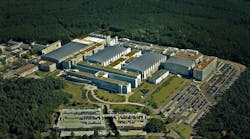Power semiconductors are a key component in the worldwide shift toward electric vehicles and renewable energy sources like solar and wind. And so Infineon Technologies, grappling with voracious demand for electronics that can manage all that electricity, is aiming to boost its chip supply with the construction of a $1.9 billion factory in Europe.
Infineon, the world’s largest maker of power semiconductors with about 18.5 percent market share, plans to start building by the first half of next year, with the investment to be spent over six years. The factory located in the Austrian city of Villach is expected to enter production of 300-millimeter wafers by 2021, creating about 400 jobs.
“[Our growth] is underpinned by global megatrends such as climate change, demographic change and increasing digitization,” said Infineon's chief executive officer Reinhard Ploss. “Electric vehicles, connected and battery-powered devices, data centers or power generation from renewable sources require efficient and reliable power semiconductors.”
“Global demand for power semiconductors is soaring,” Ploss said in a statement. “We recognized that trend early on” and the Munich, Germany-based company’s new production plant “will help us cater for the growing demand that our customers anticipate, and continue on our path to success in the coming decade,” he said.
Over the last year, the supply of power semiconductors has been lagging demand. Discrete semiconductors are on allocation for an average of almost four months, according to Electronic Components Industry Association estimates. That includes low voltages switches like power MOSFETs, which are on backorder for more than six months because of shortages.
To refill the supply chain, Infineon also said that it would maximize the 300-millimeter production capacity at its main factory located in Dresden, Germany. The Dresden fab originally manufactured 200-millimeter wafers, but it was converted to the larger diameter wafers almost two decades ago. That allowed the company to improve yields and slash costs.
The 300-millimeter manufacturing process was developed at Infineon’s Villach research laboratory before being deployed to the Dresden facility over the last two decades. Infineon said that the new 60,000-square-foot factory in Villach could potentially handle $2.1 billion in sales every year, with all the available capacity in use.
